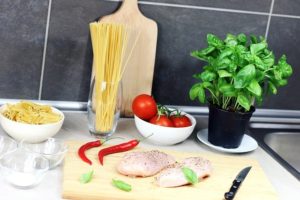 I always clean and sanitize my counter-tops and cutting boards after I prepare raw meat, but I am reminded I should being doing it more often.
I always clean and sanitize my counter-tops and cutting boards after I prepare raw meat, but I am reminded I should being doing it more often.
One in six people become sick with food borne illness each year in the U.S.
For some it is more than a day or two of diarrhea and vomiting. The very young, elderly, pregnant, chronically ill, or those with compromised immune systems are a higher risk for becoming sick from food borne illness and suffering more long term consequences, including permanent disability and death.
 To reduce your risk of food borne illness, the best habit to get into is to wash your hands, a lot! Equally important is to clean and sanitize any equipment and surfaces where food is prepared. Clean surfaces and equipment both before and after use.
To reduce your risk of food borne illness, the best habit to get into is to wash your hands, a lot! Equally important is to clean and sanitize any equipment and surfaces where food is prepared. Clean surfaces and equipment both before and after use.
Why clean and sanitize both before and after food prep?
Cleaning after cooking is a natural for most, but cleaning again before cooking is less

commonly done. Cleaning before cooking is important when you think about the possibility of family members putting dirty bags, purses backpacks etc. on your clean counters while you were not looking. Additionally, the potential that pets (think cats), rodents, flies or other insects walked across your clean counters etc. overnight is a more common occurrence than you might realize.
Clean:
Clean first with soap and water to remove food, grease and dirt. Rinse with clean water.
Sanitize:
After cleaning with soap and rinsing with water, sanitize surfaces with an approved sanitizer. Leave the sanitizer on the surface for the suggested amount of time. Allow to air dry or dry with a clean paper towel.
 One of the most effective homemade sanitizers you can use in your kitchen is a dilution of household bleach and water. Make with regular unscented chlorine bleach with a known concentration of 8.25%. If the bleach bottle does not list the percentage concentration, do not use it as a kitchen sanitizer, save it for your laundry. Mix ¼ teaspoon chlorine bleach per quart/32 oz. of warm water. Pour this solution into a spray bottle. Spray solution onto counters and food prep surfaces. Let the bleach solution sit for 1 minute. Then allow the surface to air dry or dry with a clean paper towel. For more kitchen sanitizer options using inexpensive household food safe products such as hydrogen peroxide, and vinegar, consult Cleaning & Sanitizing the Kitchen.
One of the most effective homemade sanitizers you can use in your kitchen is a dilution of household bleach and water. Make with regular unscented chlorine bleach with a known concentration of 8.25%. If the bleach bottle does not list the percentage concentration, do not use it as a kitchen sanitizer, save it for your laundry. Mix ¼ teaspoon chlorine bleach per quart/32 oz. of warm water. Pour this solution into a spray bottle. Spray solution onto counters and food prep surfaces. Let the bleach solution sit for 1 minute. Then allow the surface to air dry or dry with a clean paper towel. For more kitchen sanitizer options using inexpensive household food safe products such as hydrogen peroxide, and vinegar, consult Cleaning & Sanitizing the Kitchen.


Very helpful, Nice and interesting to read this article.Thanks for sharing your experienced
This was helpful to me because while I clean my kitchen, I have not sanitized as described in this article.
The related article Cleaning and Sanitizing the Kitchen is also very helpful. The article also emphasized using unscented bleach because the scented is not food safe. It is important to note that in the related article, the chlorine bleach used is 6% and therefore more is used per quart of water.
In the above article by Ms. Gains she uses bleach with an 8.25% concentration so she used less bleach per quart of water.
I was glad to see that the concentration of the bleach is clearly labeled on my store-brand bottle of household bleach where it lists the ingredients:”active ingredient: sodium hypochlorite: 8.25%”.
Thanks for this practical information!
Great article reminding us to clean up our kitchen